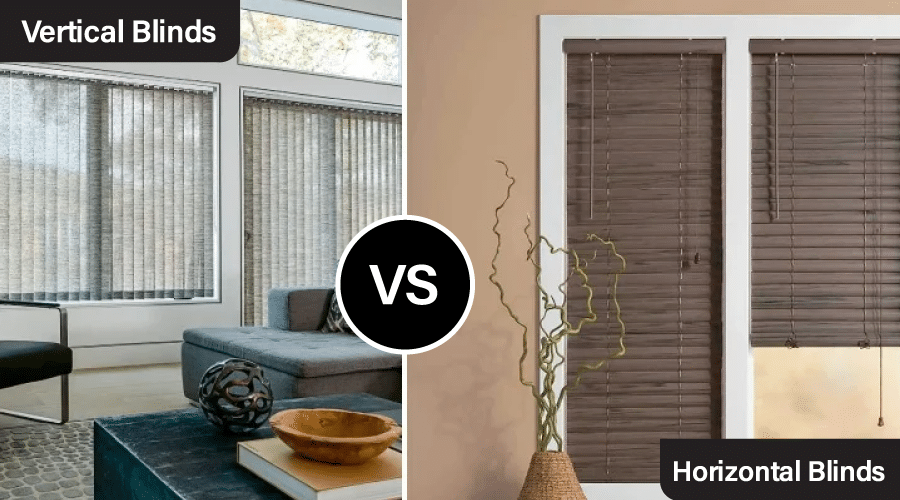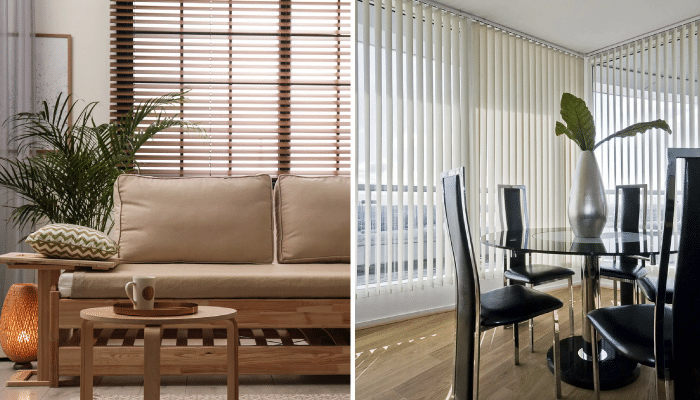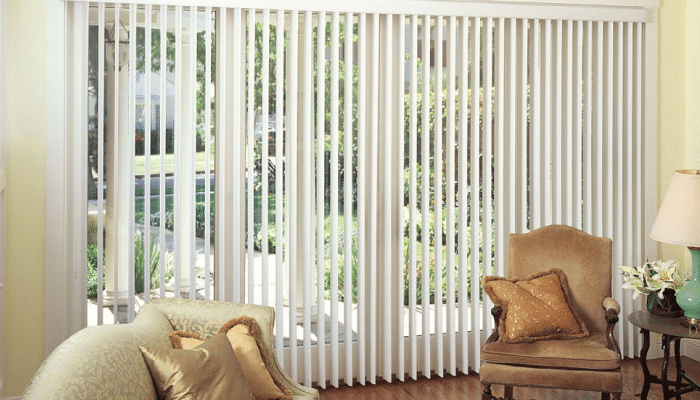Window treatments are very important for a lot of reasons such as keeping privacy, energy efficiency, brightening up the rooms, etc. One window treatment that has been more popular than most others of its kind is window blinds.

The two types of blinds, vertical and horizontal, have sparked a vertical vs horizontal blinds debate on online forums for their striking similarities.
But apart from their similarities, there are quite a few ways vertical and horizontal blinds are different as well. While vertical blinds are suitable for larger and wilder windows, while horizontal blinds suit smaller and narrower windows the best.
Horizontal blinds save a lot of space due to their small slat size while vertical blinds have larger slats. Vertical blinds are easier to clean than their counterparts.
Let’s take a deeper look at the differences between vertical and horizontal blinds.
Vertical blinds vs Horizontal blinds
Og all the window treatments available in the market, blinds are arguably the most prevalent and easiest to use. Since there are only two types of blinds, it is very easy for consumers to become embroiled in a debate about horizontal vs vertical blinds, and they have very good reasons for that.
This is because both these blinds have some distinct similarities.

The first similarity between these blinds is their ability to block almost all the light coming into the room. No matter what kind of blind you use, you can rest assured that you can block as much light as you want to.
Also, both of these blinds are made of similar materials, such as PVC and faux wood, so there is no way to differentiate between them in this regard. You can read out the article to compare faux wood vs wood blinds.
That was all for their similarities. Now, lets’ take a look at the differences between vertical and horizontal blinds
Key differences between vertical and horizontal blinds for your better understanding:
| Vertical Blinds | Horizontal Blinds |
|---|---|
| Are suitable for larger doors and windows | Are suitable for smaller and narrower windows |
| Have better light-blocking ability | Their light-blocking ability is inferior to vertical blinds |
| Easier to clean | Harder to clean |
| Take up more space | Don’t take up much space |
| Make a lot of noise | Don’t make too much noise |
| Don’t ensure much privacy | Maximum privacy is ensured |
Pros and Cons of Vertical Blinds:

Vertical blinds are very prominent in houses with large windows and patio doors. These blinds have some excellent advantages as well as some clear disadvantages as well, let’s take a look.
Pros:
- Suitable for large doors and windows: If you have large patio doors and wide windows, you should use vertical blinds for them. These blinds cover a lot of areas and hence are the perfect fit for large doors and windows.
- Cleaning them is easier: When it comes to cleaning and maintaining blinds, it is easier to clean and maintain vertical blinds than horizontal ones. This is because these blinds run from top to bottom and have no hardware running between them.
- You can also customize horizontal blinds for these kinds of doors and windows, but it will not be nearly as good.
Also, vertical blinds are made of waterproof material such as PVC, so you can use a lot of cleaning materials and methods to clean them without having to worry about them getting water damage.
- Blocking light: Although both vertical and horizontal blinds are excellent in blocking light, vertical ones have a greater light-blocking ability than horizontal ones. This comes in very handy since larger doors and windows let in much more light than smaller ones.
Cons:
- Take up a lot of space: if you don’t have a lot of space around your windows and patio doors, then you have to think twice before installing vertical blinds. Their large slats take up a lot of space, which can look quite cramped and messy.
- Noisy: Operating vertical blinds can create a lot of noise, especially compared to horizontal ones.
- Lack of privacy: Since vertical blinds are run from top to bottom, they tend to sway from side to side due to airflow inside the room. This causes a severe lack of privacy as people can easily peek into the house to see what is going on.
- Prone to wear and tear: Vertical blinds need various moving parts to move and operate. As a result, they suffer from more wear and tear.
Pros and Cons of Horizontal Blinds

Horizontal blinds are the most used blinds in the world, and whenever you see blinds in popular media, there are more chances that you will horizontal blinds than vertical ones. Here are the pros and cons of horizontal blinds.
Pros:
- Suitable for smaller windows: if you are looking for blinds for smaller and narrower windows, you must install horizontal blinds, as they are the most suitable for this purpose than vertical blinds.
- Saves a lot of space: Horizontal blinds have smaller slats, which take up a lot less space than vertical ones. So, if you don’t have much space around your windows, then horizontal blinds are your best bet.
- More privacy: Since horizontal blinds have horizontal slats, and hardware to keep them tethered to one another, they don’t sway from side to side with air.
- This makes sure there isn’t any unwanted space created between them and people are not able to look inside the house or the room, protecting the privacy of the residence and office.
- Make less noise: Unlike vertical blinds, operating horizontal blinds creates near to no noise at all. This makes the blinds easier and calmer to have in your home.
- More durable: As horizontal blinds don’t need any moving parts to operate, they last a long time since they don’t wear and tear as often.
Cons:
- Letting in more light: As the slats of the horizontal blinds are, well, horizontal, and the sun shines from above, they tend to let in more light than vertical blinds.
- Difficult to clean: The slats of the horizontal blinds have threads and other hardware running through them, making them harder to clean.
Vertical or horizontal blinds: which is better?
It is very easy to become engaged in a vertical vs horizontal blind debate since these two blinds are made of the same materials and has the same purpose. The best blinds are the one that suits the needs of the users the best.
If you have large windows and patio doors, you have to go for vertical blinds. On the other hand, having narrower windows will require you to install horizontal blinds. Read the article to learn how to measure windows.
FAQ‘s
Can you mix vertical and horizontal blinds?
Yes, you can mix vertical and horizontal blinds. This will make sure your room has a consistent look no matter what the application is. Also, there are no obligations to make sure your vertical and horizontal blinds have to match.
What can I use instead of vertical blinds?
There are plenty of alternatives to vertical blinds that you can use. Some of them are
- Sliding Panels
- Long curtain panels
- Solar shades
- Cordless cellular shades
- Roman shades
Can you put horizontal blinds on a sliding door?
Although it is possible to customize horizontal shades to use on a sliding door, it is not recommended. One of the reasons behind this is the weight of the horizontal blinds will be too much for you to operate smoothly.

